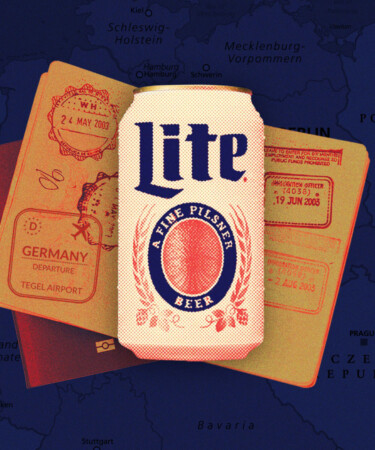We all know travel has the potential to be transformative. But Miller Lite, one of the best-selling beers in American history, was actually conceived over a bratwurst on the streets of Germany.
After two decades of hot potato for the reins of the Miller Brewing Company, the brand was sold to nicotine mega-conglomerate Philip Morris in 1969. The following year, while Philip Morris president George Weissman and newly appointed Miller CEO John Murphy were on a business trip in Germany for matters unrelated to the Miller brand, the duo sat down for lunch and a pint of “diet” beer. While American brewers were just starting to tease the idea of a light beer, Germans had been making the stuff since the ‘30s. Coincidentally, Weissman had diabetes in his family, and the idea of a low-carb beer intrigued him. And with that, the seed had been planted.
When Weissman and Murphy landed back in Chicago, they immediately embarked on a quest to make a light beer for Miller. Using Philip Morris’s near-infinite bankroll, they purchased Meister Bräu, a nearby brewery that was teetering on bankruptcy, and all the recipes that came with it. They tasked Miller’s brewers to tweak the recipe for Meister Bräu Light, and in 1975, Miller Lite hit shelves nationwide.
At that point, the calorie-counting craze was on the rise in the United States. Unfortunately for beer brands, the U.S. government had placed restrictions on advertising that promoted beer as a weight-loss aid. Surrounded by beer companies starting from square one on messaging for largely unsuccessful light beers, Weissman and Murphy had their work cut out for them. What followed were a few strokes of advertising prowess coupled with impeccable timing.
Though consumers had become more health-conscious, beer still proudly thrived on its masculine stigma in the ‘70s. The guys behind Miller used that antiquated thinking to their advantage. Rather than marketing their light beer as a means of slimming down as brands before them had, they offered drinkers the opportunity for “tough” drinkers to crush more of it. Miller hired retired athletes to harden the beer’s image: One ad featured former NFL player Bubba Smith savagely ripping a can of Miller in half to demonstrate how he “loves the easy-open can.” Around this time, Miller also launched its famous “tastes great, less filling” campaign, which boasted Miller Lite as both low-carb and a beer that you could drink a lot of. It even specifically named the beer using the L-I-T-E spelling to avoid any legal consequences for promoting a “light” beer.
Overwhelming success followed: A mere two years after Miller Lite’s release, Miller owned a whopping 10 percent of the beer market in the U.S. and the company’s overall sales leapt by 43 percent. With the waning popularity of Schlitz by the late ‘70s, Miller and Anheuser Busch were the country’s two dueling beer giants. Coors Light came into the picture in 1978, and Bud Light hit the scene soon after, but both brands had a lot of catching up to do.
The next few decades would begin a low-cal battle between America’s macrobreweries to become the best-selling light beer brand — a battle we know today as the Light Beer Wars. In a pivotal moment, Miller Lite proved that having a great product is only the first step to success. The second is how you sell it.
